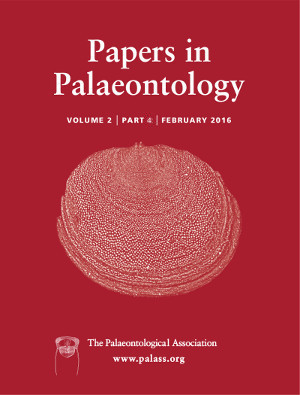Reg. Charity No. 1168330

Abundant new material of Roveacrinida from the upper Santonian and lower Campanian chalk of southern England, the lower Campanian Taylor Formation of Texas, the Maastrichtian Prairie Bluff Formation of Mississippi and the lower Campanian rocky shoreline deposits of Ivö Klack, southern Sweden is described. The Saccocomidae, subfamily Saccocominae, are represented by Costatocrinus gen. nov., with included species C. brydonei sp. nov. (type species) and C. mortimorei sp. nov. The Saccocomidae, subfamily Applinocrininae, genus Applinocrinus, includes A. cretaceus (Bather), A. texanus Peck and A. russelli sp. nov. Sagittacrinus gen. nov. (type species: S. torpedo sp. nov.) is represented only by highly distinctive primibrachials. The ‘ventral cover plates’ of Applinocrininae are re‐interpreted as modified brachials. Roveacrinidae (Roveacrininae) is represented by Roveacrinus communis Douglas, R. bairstowi Peck and Jakeocrinus gen. nov. (type species: J. ellisensis sp. nov.). A new subfamily, Hessicrininae, characterized particularly by skeletal reduction through the development of fenestrae and foramina, and many with long processes from radials and basals, is established for Platelicrinus Destombes & Breton, Lucernacrinus gen. nov. (type species: L. woodi sp. nov.), Hessicrinus gen. nov. (type species: H. filigree sp. nov.; also H. scalaensis sp. nov.), Stellacrinus gen. nov. (type species: S. hugesae sp. nov.; and forma cristatus nov.), S. pannosus sp. nov., and the aberrant Cultellacrinus gen. nov., which lacks arms (type species: C. gladius sp. nov.). The Santonian–Maastrichtian roveacrinids represent a fourth and final radiation of the family. Cladistic analysis of the Hessicrininae subfam. nov. supports the monophyly of the subfamily, and indicates that the most derived taxa are Stellacrinus gen. nov. and Cultellacrinus gen. nov. From adaptive morphological data, patterns of distribution and palaeoenvironmental information, it is concluded that these crinoids lived as mesoplankton. The short ranges and wide geographical distribution offer considerable biostratigraphical potential.